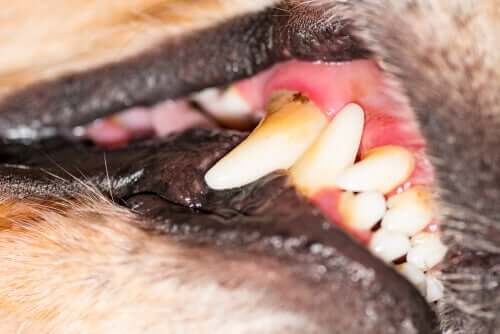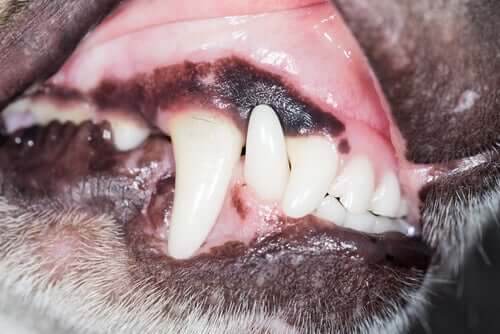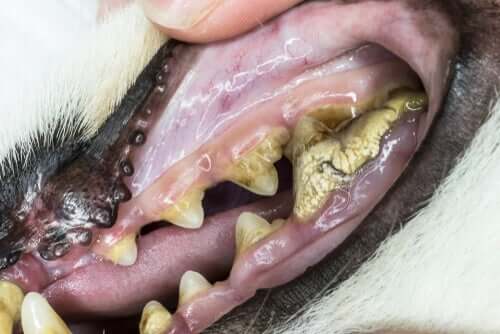Gum Disease in Dogs: Symptoms and Treatment

Gum disease in dogs, also known as periodontal disease, causes the weakening and eventual loss of the structures that support the teeth. It can result in significant problems for a dog’s mouth, including eroded gums, bad breath, tooth loss, bone loss, and chronic pain.
In this article, you’ll learn about how this disease comes about and what you need to do to address it.
What is gum disease in dogs?
Canine periodontitis is an oral bacterial infection and consists of four stages.
It starts with the formation of tartar and slightly inflamed gums and progresses towards gingivitis (stage 2). This progresses to mild and, eventually, severe periodontal disease, which can lead to loss of bone or teeth, with an excessive build-up of tartar.
What are the signs to look out for?
The first thing you can do at home is simply to look for signs of oral disease. Lift up your dog’s lip and ask yourself the following questions:
- Does your dog have bad breath? This is one of the first signs of periodontal disease.
- Does your dog have red or swollen gums?
- Are your dog’s teeth yellow or brown? Does your dog have any loose teeth or have they lost any?
- What’s your dog’s appetite like? Do they still play fetch? Do they have trouble chewing bones? Have they lost weight?
If you answered ‘yes’ to any of the above questions, your dog may have gum disease. But don’t worry, there’s still time to address it.

Why mustn’t you ignore gum disease in dogs?
The bacterial infection causes erosion of the gums, teeth, and bones, which in turn causes chronic pain. It can also cause the loss of teeth and bone.
But that’s not all. Gum disease in dogs also increases the risk of heart, kidney and liver disease. All of these things can be prevented if you adopt the right dental hygiene measures for your dog.
Often, symptoms are only noticed in older dogs with advanced periodontal disease. But despite this, we know that 9 out of 10 dogs aged three years old have gum disease. That’s a shocking statistic.
Causes of gum disease in dogs
Gum disease begins when bacteria, food, and saliva combine to form plaque. This plaque covers the teeth and, after a couple of days, this combines with minerals and hardens to become tartar.
The dog’s immune system tries to fight the bacteria in plaque and this causes the gums to become red and inflamed. The tartar then continues to build up and starts to separate the gums from the teeth.
This separation of the gums creates a gap between the teeth and the gums which is the ideal space for bacteria to multiply.

As the disease advances, abscesses begin to form and the surrounding tissues are destroyed. The teeth become loose and the bone deteriorates.
Treating gum disease in dogs
A brief physical examination will be enough to spot swollen gums and a build-up of tartar. A complete oral exam, however, can only be done under a general anesthetic.
If your vet suspects that your dog has gum disease, they’ll recommend dental treatment. They’ll examine the teeth and gums more thoroughly and do a thorough clean under anesthetic.
So that your dog doesn’t have to go under anesthetic more than once, it’s a good idea to carry out any treatment or extractions at the same time as the cleaning.
Up to 60% of periodontal disease develops below the gum line. As a result, a dental x-ray can be a valuable tool for detecting bone loss or deterioration.
Prevention is the best treatment
Periodontal disease is irreversible and any intervention is purely to try to control it. Therefore, the best way to keep your dog’s teeth healthy is through preventive dental hygiene. Start brushing your dog’s teeth when they’re still a puppy and book a cleaning session at the vet once a year.
Most pet stores sell toothpaste approved for animals. They can also be flavored, which helps your dog to tolerate or even enjoy having their teeth brushed.
As long as you establish a good dental care routine at home and book regular cleanings with your vet, you’ll be able to prevent gum disease in your dog.
All cited sources were thoroughly reviewed by our team to ensure their quality, reliability, currency, and validity. The bibliography of this article was considered reliable and of academic or scientific accuracy.
- Sanromán, F., Montolio, J., & Llorens, M. P. (1990). Estudio Comparativo de dos Tipos Diferentes de Implantes Dentarios en Perros. Estudio Experimental. Journal of Veterinary Medicine Series A, 37(1‐10), 138-147.
- Toriggia, P. G. (2014). Enfermedad periodontal en el perro: Características ultramicroscópicas de dientes afectados y sus modificaciones con la terapia periodóncica (Doctoral dissertation, Servicio de Cirugía de Pequeños Animales de Hospital Escuela de Medicina Veterinaria, Facultad de Ciencias Veterinarias, Universidad de Buenos Aires).
- Hennet, P. (2006). Nutrición y salud oral en el perro. Royal Canin, IVIS.
